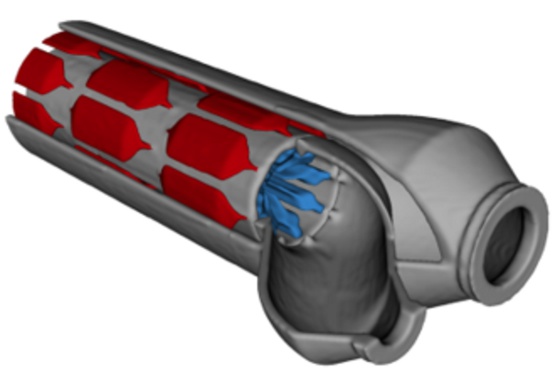 |
| October 05, 2021 | Volume 17 Issue 37 |
Designfax weekly eMagazine
Archives
Partners
Manufacturing Center
Product Spotlight
Modern Applications News
Metalworking Ideas For
Today's Job Shops
Tooling and Production
Strategies for large
metalworking plants
Researchers design extreme heat exchanger using metal 3D printing

Computer Tomography (CT) X-ray image of the tube-in-tube heat exchanger. Color indicates hot fluid (red) in the outer tube or cold fluid (blue) in the inner tube. [Credit: Hyunkyu Moon, Davis McGregor, Nenad Miljkovic and William P. King, University of Illinois Urbana-Champaign]
Demonstrating next-generation energy technology, researchers at the University of Illinois Urbana-Champaign are using topology optimization and metal 3D printing to design ultra-compact, high-power heat exchangers.
Used in most major industries -- including energy, water, manufacturing, transportation, construction, electronic, chemical, petrochemical, agriculture, and aerospace -- heat exchangers transfer thermal energy from one medium to another.
For decades, heat exchanger designs have remained relatively unchanged. Recent advancements in 3D printing allow the production of three-dimensional exchanger designs previously thought impossible. These new and innovative designs operate significantly more effectively and efficiently but require specific software tools and design methods to manufacture the high-performance devices.
Recognizing the need to unlock new, high-performing heat exchangers, Grainger College of Engineering researchers have developed software tools that enable new 3D heat exchanger designs.
"We developed shape-optimization software to design a high-performance heat exchanger," said William King, professor of Mechanical Science and Engineering at The Grainger College of Engineering and co-study leader. "The software allows us to identity 3D designs that are significantly different and better than conventional designs."
The team started by studying a type of exchanger known as a tube-in-tube heat exchanger, where one tube is nested inside another tube. Tube-in-tube heat exchangers are commonly used in drinking water and building energy systems. Using a combination of the shape-optimization software and additive manufacturing, the researchers designed fins (only made possible using metal 3D printing) internal to the tubes.
"We designed, fabricated, and tested an optimized tube-in-tube heat exchanger," said Nenad Miljkovic, associate professor of Mechanical Science and Engineering and co-study leader. "Our optimized heat exchanger has about 20 times higher volumetric power density than a current state-of-the-art commercial tube-in-tube device."
With billions of heat exchangers in use worldwide today and even more attention placed on our need to reduce fossil fuel consumption, compact and efficient heat exchangers are increasing in demand, particularly in industries where heat exchanger size and mass significantly impacts performance, range, and costs.
The article, "Ultra-power-dense heat exchanger development through genetic algorithm design and additive manufacturing," written by Hyunkyu Moon, Davis McGregor, Nenad Miljkovic, and William P. King, is published in the journal Joule.
This research was sponsored by the National Science Foundation Engineering Research Center for Power Optimization of Electro-Thermal systems (POETS) and the International Institute for Carbon Neutral Energy Research (WPI-I2CNER).
Source: University of Illinois Urbana-Champaign
Published October 2021
Rate this article
View our terms of use and privacy policy
